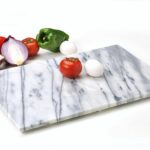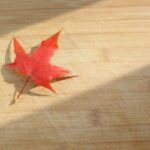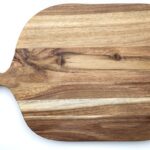To prevent food poisoning, it is important to keep your kitchen tools clean and sanitized. Cutting boards are one of these items that can harbor bacteria if not cleaned properly. The knife scars trap bacteria that are hard to clean by hand. Putting cutting boards in the dishwasher is the easiest and most effective method of cleaning. Hot water will kill the bacteria even those hidden deep in the scars. However, before putting it in the dishwasher, always check if your board is labeled as dishwasher safe.
Some dishwashers have a sanitizing cycle that helps to kill 99.99 % of bacteria from your dishes. Don’t use an antibacterial cycle regularly because frequent washing with very hot water (150°F) can shorten the lifespan of your cutting boards.
Dishwashers also have a drying cycle that is designed to remove moisture, so your cutting boards will come out clean and ready to store. When completely dry cutting boards will not tend to grow bacteria and germs. To maximize the drying process, make sure that your dishwasher is not overloaded and that your cutting boards don’t touch each other or other items.
Dishwasher Safe Cutting Boards
1. Plastic Cutting Boards

The plastic cutting boards are made of BPA-free polypropylene. This material is, non-porous, doesn’t harbor odors, and is moderately gentle on knives.
The major advantage of plastic cutting boards is that they don’t require a lot of maintenance. They are dishwasher safe and won’t get damaged after many dishwashing cycles.
Downsides: The main downside of plastic cutting boards is that plastic is not an inert material. No one wants plastic particles in their food. When you are cutting food on the plastic cutting board, a sharp knife can leave cuttings and scratches on the surface. The plastic particles chipped away can remain in food and can get into your meals.
Another downside is that plastic boards slide around while you are cutting. The exception is boards rounded by non-slip edges or equipped with non-slip rubber feet.
Wheat Straw Plastic Cutting Boards
These plastic cutting boards are made from wheat straw leftover and high-density plastic pressed by high temperatures. Wheat straw plastic boards are stronger and more attractive than regular plastic boards. They are non-porous, lightweight, degradable, and dishwasher-safe for your convenience.
2. Silicone Cutting Boards
Food-grade silicone is safe for contact with foods. Silicone is an inert material, so you don’t have to worry about silicone particles in your food. It also doesn’t tend to breed bacteria on the surface.
Silicone cutting boards are foldable for easy transport of chopped food and easy storage after washing. The surface is non-slip and knife-friendly but not cut-resistant.
Silicone cutting boards usually come in sets and are color-coded for cutting different foods. They will add bright colors to your kitchen. Their lifespan is shorter than most other cutting boards. However, they are pretty affordable, so you can buy a new set of boards from time to time.
Silicone cutting boards are easy to keep clean and odor-free. They are dishwasher safe and don’t pick stains easily. They are very convenient and the perfect choice if you prefer low-maintenance and hygienic cutting boards.
3. Composite Cutting Boards
These cutting boards are made from environmentally friendly wood fiber and recycled paper. According to Epicurean USA Customer Service, the material is completely non-toxic and is approved by the National Sanitary Fountain to be safe for food contact.
You don’t have to often resharpen your blades as these lightweight boards are easier on the knives than glass, acacia, teak, or maple.
Wood fiber cutting boards have a natural look and feel of wood. However, unlike wood, composite cutting boards are dishwasher safe and don’t require oiling or any special maintenance. You can use them as elegant serving trays.
It seems that wooden composite cutting boards are made to meet the needs of people who are fond of wooden cutting boards but also want to enjoy the convenience of dishwasher-safe kitchen tools.
Downsides:
Composite boards are not fully resistant to moisture. However, don’t blame the dishwasher if your board has cracked or has started to warp. Even if you wash it by hand it will wear over time. To reduce the chances of warping, never leave it lying flat if not completely dry.
It is just a matter of time before you will notice that it doesn’t lay flat on your countertop. In the meantime, enjoy it. It looks nice and saves you from hand washing and oiling unlike a cutting board made from real wood.
Some people noticed that their composite cutting board has a bad odor, especially when wet. The unpleasant smell will disappear after approximately 3-4 washing cycles or several washes by hand.
Brands: Epicurean Non-Slip Series Cutting Board, Cutting Board for Kitchen by Freshware, and Wood Fiber Cutting Board by TOPTIER.
4. Stainless Steel Cutting Boards
These cutting boards are made of 304 food-grade stainless steel and are corrosion-resistant, non-porous, and indestructible. They look attractive and you can use them as a dinner platter.
However, stainless steel is not gentle on your kitchen knives.
Stainless steel cutting boards are hygienic and don’t tend to collect bacteria, stains, or odors. They are easy to clean and are dishwasher-safe. They are thin and will take up little space in your dishwasher or kitchen cabinet.
Are Wooden Cutting Boards Dishwasher-Safe?

Many people enjoy cutting foods on natural wood. Wooden cutting boards look beautiful but they require so much effort. You need to hand wash them as they would be damaged if you put them in the dishwasher. Wood is a porous material that will warp, splinter, and crack when exposed to moisture. To keep wooden boards in good condition, you need to oil them periodically.
If a wood cutting board is your preferred choice, it would be very convenient to have a set of dishwasher-safe cutting boards handy in the kitchen for your everyday cooking needs.
Are Bamboo Cutting Boards Dishwasher-Safe?
Bamboo cutting boards are eco-friendly, lightweight, and pleasing to the eye. They are less porous and harder than wood, which means that they will dull the blades of your knives quicker than wood.
Bamboo cutting boards require hand washing and oiling because the bamboo can splinter when not maintained properly.
Some bamboo cutting boards are advertised as dishwasher safe but they will show signs of chipping and splintering after several hot dishwasher cycles.
What about Large Cutting Boards?
Some large and heavy cutting boards such as those made of granite, marble, or tempered glass are not suitable for putting in the dishwasher due to their size or heaviness. Smaller tempered glass cutting boards that are not meant to be built into the countertop are dishwasher safe. However, keep in mind that glass, granite, and marble cutting boards are not good for your knives.



